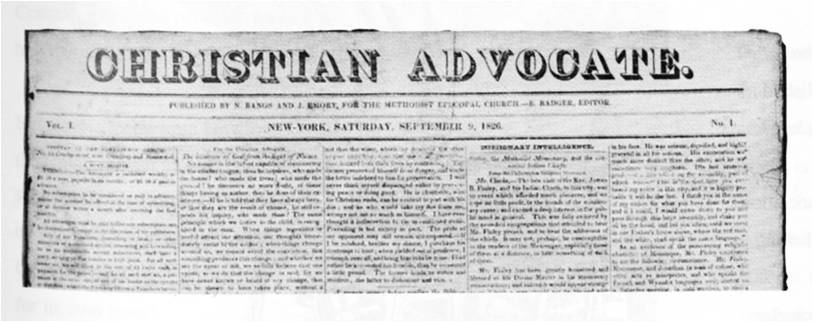How the 19th Century Divine Healing Movement Nearly Met Its End
Guest post by Randy Clark
The Divine Healing movement, also known as the Faith Cure movement, was the most controversial movement within Protestant Christianity in the latter quarter of the 19th century. Given its explosive growth, especially through the Holiness movement that likewise experienced explosive growth, it is hard to believe that its memory was almost totally lost. Paul Chappell’s 1985 doctoral dissertation, Origins of the Divine Healing Movement in America, helped re-awaken the churches to this movement of healing. He argued that in an unlikely turn of affairs, two liberals and a fundamentalist were the primary writers and leaders responsible for opposing and nearly squelching the story of the 19th-century Divine Healing movement.

Clip of the Christian Advocate | UMPH.org
How did this happen? Three principal people had a negative impact on the rebirth of healing within Protestantism. James Buckley, a Methodist, was the editor of the largest Christian magazine in the USA, the Methodist Christian Advocate, for 32 years until 1912. A theologically trained, liberal leader, he wrote against both the Faith Cure movement and the early Pentecostal movement. His writing suggested that only fringe groups would believe in healing, not orthodox believers. Buckley typically generalized and lumped in Christian Science healing with Faith Cure movement and later the Pentecostal movement. He, like other modern critics, only spoke of the most bizarre practices, highlighting those who didn’t believe in medicine and neglecting to quote the most balanced leaders, like Dr. Cullis, William Broadman, Johann Blumhardt, and A. J. Gordon who all embraced the medical field. Buckley only spoke of the bad and never mentioned the good that was happening in the Faith Cure (Divine Healing) and Pentecostal movements.
Another influential person to negatively impact the Faith Cure and Pentecostal movements was William Warren Sweet. His The Story of Religion in America (published in 1930 and edited and republished for 30 years) completely left them out of the story. For Sweet mainline Protestantism was the Christianity of America. He paid little attention to Roman Catholicism and none to Pentecostalism or the Faith Cure movement.

B.B. Warfield | Wikipedia
A third opponent, fundamentalist Presbyterian B. B. Warfield, wrote Counterfeit Miracles, in which he argued that healings, miracles, and gifts of the Spirit ended after the formation of the New Testament and death of the Apostles. Many saw Warfield’s writings as the last nail in the coffin of continuationism; few could rebut his arguments. Today, just as in the 19th century, a number of Christians hold to this cessationist position.
However, as Dr. Jon Ruthven points out in his book On the Cessation of the Charismata: The Protestant Polemic on Postbiblical Miracles (1993), critics argue that Warfield’s objections are inconsistent with his own principles of biblical interpretation. Moreover, Warfield argued against the anti-supernaturalism of liberalism for the miracles in the Bible, but when it came to the reports and testimonies of miracles in the history of the church, Warfield utilized the same anti-supernatural arguments liberal theologians had used against the biblical miracles.
No doubt Warfield, Buckley, and Sweet would find little else to agree upon, but ironically and in this way, both liberalism and fundamentalism have equally rejected belief in healing and miracles. Even so, church history and historical theology both reveal that faith in healing through prayer has been part of Christian faith through its whole history. The Roman Catholic Church, Orthodox Churches, Holiness denominations, Pentecostal denominations, Charismatic denominations, and charismatics within the historical denominations around the world, as well as other large and quickly multiplying church networks, all believe healing has continued and still occurs in their churches.
Though modern evangelicals perhaps believe otherwise, only a small minority of denominations, primarily Lutheran and Reformed, hold to a strict cessationism. Luther himself believed healing was possible in response to prayer, and Calvin believed when a new region of the world was being evangelized the gifts of healing and miracles could occur again.
The secular historian of Yale University, Ramsay MacMullen, in his quest to discover how the early church, which was illegal and persecuted, became the official religion of the Roman Empire discovered two primary reasons why: the power in Christianity to deliver the demonized and heal the sick. I believe how the church evangelized the pagans of the first few centuries is how the church can reach the pagans of the 21st century—through the preaching of the gospel accompanied by signs and wonders, healings and miracles.
Randy Clark is overseer of the Apostolic Network of Global Awakening, president of the Global Awakening Theological Seminary of Family of Faith Christian University, and author of 40 books including There is More and Intimacy with God. For more on the history of divine healings, read our issue #142 here.



